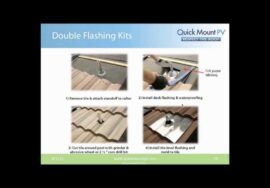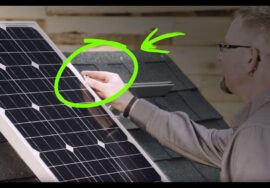Testing Drip Edge Installations on Roofing | Ask This Old House
Ask This Old House general contractor Tom Silva demonstrates the importance of a properly installed drip edge
SUBSCRIBE to This Old House:
Skill Level: Moderate
Steps:
1. A roof without a drip edge can draw water off the roof into the end grain of the sheathing through surface tension, rotting the sheathing, the fascia, and the structure underneath.
2. A metal drip edge will help protect the sheathing under the roof, but if it’s installed too closely to the fascia board, it can still cause water to be drawn into the fascia.
3. The best installation method is to leave a gap between the drip edge and the fascia board, about the width of a finger. The shingles should also overhang the drip edge 3⁄8 to _ of an inch.
Resources:
Drip edges and shingles can be found at home centers.
About Ask This Old House TV:
Homeowners have a virtual truckload of questions for us on smaller projects, and we're ready to answer. Ask This Old House solves the steady stream of home improvement problems faced by our viewers—and we make house calls! Ask This Old House features some familiar faces from This Old House, including Kevin O'Connor, general contractor Tom Silva, plumbing and heating expert Richard Trethewey, and landscape contractor Roger Cook.
Follow This Old House and Ask This Old House:
Facebook:
Twitter:
Pinterest:
Instagram:
Tumblr:
For more on This Old House and Ask This Old House, visit us at:
Testing Drip Edge Installations on Roofing | Ask This Old House












I would assume this is a gutter-less installation. Best to install a gutter..
Standard 8″ drip edge? let me see you pick that up at your local Lowes.
Jeff Holland Oh! No they are NOT standard. In Homelo-depolo they are in the roofing section… 10 or 10.5 FEET long lol. I had to change my reply midstream lol. No 8-inchers.
Lets see the “Contractor staff” (Lowes or Home Depot) even know what the hell roof drip edge is…..
They acted like I was on crack for asking for a toilet insulation to kit to help with the condensation problems in winter in North Carolina. They claimed no such thing existed and why would you need to insulation a toilet tank from sweating/collecting humid moist air for having cold water inside side it, which chills down the ceramic….
Jeff Holland my local lowes closed recently. Lol
@BlackSwan912 Yeah I believe Tommy when he said 8″,, its the standard part I question. I don’t shop at building supply stores in Boston but that looks like a specialty item to me.
Lowe’s blowes but the cheapo depot is not much better..
The shingles should also overhang the drip edge 3⁄8″ to an inch.
Where can I find 8” drip edge? I’ll order, if needs be, I googled it, can’t seem to find it
Always learn something from you. Thanks!
The 2nd one is fine if you overhang the single 1/2″ over. They were just showing drip edge only.
8″ is not standard here. That is custom order stuff in style D. Standard is around 3″ on the top face, 6″ total.
The shingle over-hang should be about 7/8″, or the first knuckle length of your pointer finger, past the drip edge. 3/8″ as mentioned here may not be enough.
3/8″ gap, does that create a problem with insects or bees? Why not extend the shingles 3/8″ past the drip edge?
Drip edge flush with fascia. Shingles overhang 3/4 inch. Normally we wrap fascia with trim coil on our jobs.
@B Yes, that is what I do.
@Robert111 was thinking that too, is that what u do ?
Yes, spider haven, yellow jacket nests, and even termites. I would never create such a gap there. Never create a gap. Overhang shingles an inch or so and put the drip edge flush to the facia. Homeowner should keep paint on facia in good condition and there will be no rot. Drip edge will kick out most of the water.
Anyone (but especially this old house): a roofing buddy says he never installs flashing, because inevitably, it separates from the plywood over time, and becomes a source of water seepage. Thoughts?
I live in Dallas, Texas, and I’ve yet to see a house that does drip edges Tom’s way here. Could there be a climate reason for that, or are we simply all doing it wrong?
How about simply using composite material for the fascia board – won’t rot and no painting needed…no worries. I would still use a drip edge to protect the leading edge of the roof sheathing.
Can you guys please do a video on makeing ramps? thankyou and please keep the great content coming
This is genius. I’m going to rip out the gutters and install these.
Can you guys please do a video on GFCI breakers.
Now I wanna check my mom’s and my sister’s houses to see if this was installed right or at all.
Close your eyes and listen to the water…feel the urge.
Why is nobody talking about the red flash at 1:00 (0:59)?
The overhang size or drip edge gap should also consider the pitch of the roof, that adds/lessen the velocity of the water.
If my roof is already installed how do I extend the shingles
If the front shingles are still in good shape but simply don’t extend far enough to hang over the front edge, you can usually peel back the front row and install a new front row underneath. Use roof sealant when you fold the older shingles back down.
Insert 3/4″ drip cap or deeper (used for exterior casings) upside down between the drip edge and the starter shingles. This an easy and effective solution. In fact this method also works to force water into gutters that previously stuck to fascias–insert the drip cap (proper side up) between the kick-out portion of the drip cap and fascia. If you’re replacing your roof, ask the roofer to install rite-flow drip edging, which has a kick-out at the top for the drip edge, and not just at the bottom.
@ROB-IN-PHILLY And for safety don’t forget your skyhook
@electricalron He could also use a Henweigh too!
Use a shingle stretcher.